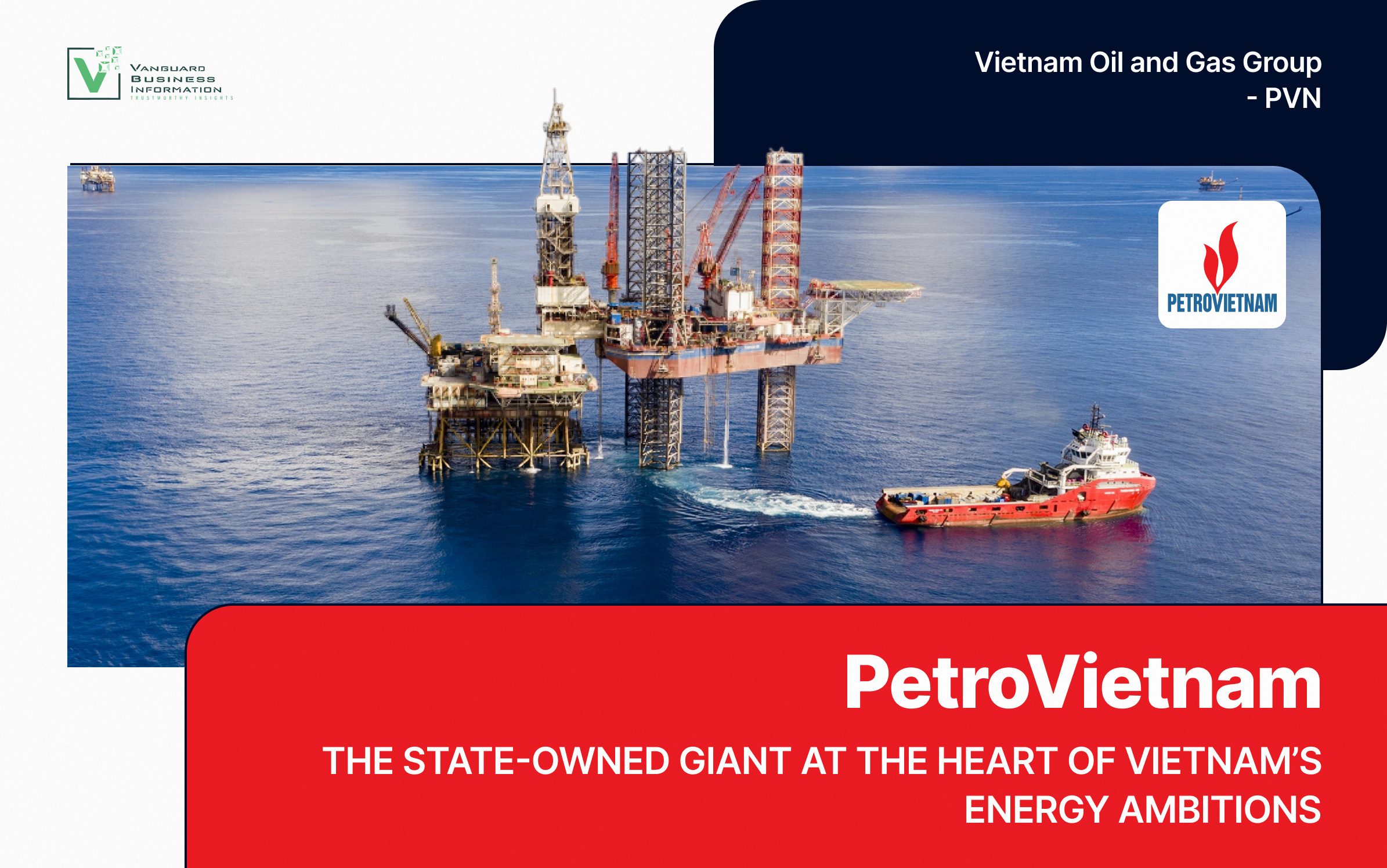Published Sep 2025
PetroVietnam: The State-Owned Giant at the Heart of Vietnam’s Energy Ambitions
Discover the power and complexity behind PetroVietnam, Vietnam’s state-owned energy giant. This article explores the group’s financial performance, strategic role in the national economy, and the controversies shaping its legacy. Will it lead Vietnam’s energy future or fall behind in a shifting global landscape? Read on to uncover this energy powerhouse's facts, figures, and future.

A Pillar of Vietnam’s Energy Economy
At the heart of Vietnam’s industrial landscape stands PetroVietnam, officially known as Vietnam National Industry – Energy Group. As a state-owned behemoth, PetroVietnam’s influence spans oil and gas exploration, electricity generation, petrochemicals, and renewable energy. With over 60,000 employees and total assets exceeding USD 22.68 billion, the group is a corporate entity and a strategic engine of Vietnam’s energy security and economic development.
Founded in 2010 as a one-member limited liability company under the Ministry of Finance, PetroVietnam has its headquarters in Hanoi and operates nationwide, with major branches in Can Tho and other key industrial hubs. Its operations encompass everything from oil and gas extraction, pipeline infrastructure, and power production to fertilizer manufacturing and clean energy initiatives.
Impressive Financials—But Signs of Volatility
PetroVietnam posted a solid financial performance in 2024, with total sales of USD 9.33 billion, up 21% year-over-year, and a net profit of USD 1.23 billion, up a striking 47.45%. This profit growth, which followed two years of more modest performance, signals a strong rebound in global oil prices and efficient cost restructuring
|
Year |
Revenue (USD) |
Profit (USD) |
Asset Growth |
Profit Growth |
|
2022 |
8.04 billion |
683 million |
+1.5% |
-4.01% |
|
2023 |
7.71 billion |
837 million |
+0.74% |
+22.57% |
|
2024 |
9.33 billion |
1.23 billion |
+5.54% |
+47.45% |
However, a closer look at past performance reveals financial volatility. In 2023, sales declined by 4.13%, and profit margins have historically been vulnerable to shifts in global energy prices and domestic fuel policies.
Moreover, while equity grew slightly to USD 15.58 billion in 2024, it had declined in 2023, raising concerns about capital erosion in prior years. This uneven performance illustrates how exposed the group is to external shocks, ranging from global commodity markets to regulatory interventions at home.
Political Ties and Centralized Control
PetroVietnam is 100% state-owned, with the Ministry of Finance as its sole shareholder. This structure ensures strong government support and entangles the group in bureaucratic oversight and political accountability.
Mr. Le Manh Hung, the group’s Chairman, and Mr. Le Ngoc Son, the General Director, oversee its strategic direction. Both are seasoned industry professionals, yet their leadership is ultimately subject to Vietnam’s broader national energy policies and Party-led economic planning.
This close relationship between business and state can be a double-edged sword. On one hand, PetroVietnam enjoys preferential access to infrastructure, land, and licensing. On the other hand, it is often caught in the middle of subsidy debates, fuel pricing reforms, and anti-corruption investigations that have rocked several Vietnamese SOEs in recent years.
Core Business Lines and Economic Role
PetroVietnam’s activities span a broad spectrum of Vietnam’s energy chain:
- Upstream: Exploration, drilling, and production of oil and gas in both domestic and international waters
- Midstream: Pipeline construction, gas gathering, and processing facilities
- Downstream: Refining, petrochemical production, LNG terminals, and fertilizer plants
- Electricity: Hydropower, thermal power, and emerging investments in solar and wind
- Services: Engineering, construction, logistics, and human resource support for oil and gas operations
With such breadth, PetroVietnam is a linchpin of Vietnam’s energy security. It meets a large share of domestic fuel demand, reduces dependence on foreign oil, and supports downstream industries such as chemicals and plastics.
A Mixed Legacy: Achievements and Controversies
Over the past decade, PetroVietnam has been both lauded and criticized. Its achievements include:
- Pioneering Vietnam’s presence in offshore oil blocks
- Developing key gas-fired power plants and industrial zones
- Leading in domestic oil refining capacity (e.g., Dung Quat and Nghi Son refineries)
- Contributing significantly to national tax revenues and GDP
However, the group has also faced public scrutiny and scandals, especially from 2016 to 2018, when multiple former executives were arrested for corruption and mismanagement. These events damaged PetroVietnam’s reputation and led to greater state oversight and internal restructuring.
Even today, PetroVietnam walks a delicate line between being a commercial enterprise and a political instrument of energy policy and social stability.
Transitioning to Renewables: A Promising Yet Limited Role
Vietnam has ambitious green energy goals to reach 30% renewable energy in its national mix by 2030. PetroVietnam intends to enter the wind, solar, and biofuel sectors. However, its progress remains modest compared to private-sector pioneers and foreign investors.
While the group has invested in biofuels and solar rooftops, these still represent a small fraction of its portfolio. Its infrastructure, workforce, and capital are still overwhelmingly aligned with fossil fuel operations.
In short, PetroVietnam is positioned to support the energy transition, but has yet to show transformative leadership.
The Road Ahead: Strategic Importance and Competitive Pressures
As Vietnam’s economy grows, energy demand is expected to increase by 8–10% annually. PetroVietnam will continue to play a central role in meeting that demand. However, it faces challenges:
- Global decarbonization: International pressure to reduce emissions may shrink export markets and raise compliance costs.
- Domestic liberalization: Vietnam’s electricity and fuel markets are gradually opening, forcing PetroVietnam to become more competitive.
- Capital efficiency: With over USD 11.5 billion in paid-up capital, PetroVietnam must prove its ability to generate more substantial returns in a more transparent environment.
- Innovation pressure: Competing with agile, tech-savvy players in LNG, renewables, and hydrogen may stretch the group’s legacy systems.
Conclusion: PetroVietnam at a Crossroads
PetroVietnam is undoubtedly one of Vietnam’s most important state-owned enterprises—a backbone of its energy system and a key fiscal contributor. Its 2024 financial rebound underscores its strategic importance. Yet, it also embodies the tension between centralized economic control and market-driven efficiency.
To stay relevant, PetroVietnam must:
- Deepen transparency and governance reforms
- Accelerate renewable energy diversification
- Compete effectively in liberalizing energy markets
- Maintain social responsibility while pursuing profitability
Whether it can do so will shape its future and the future of Vietnam’s energy independence, industrial growth, and climate resilience.


